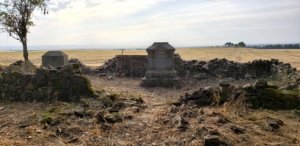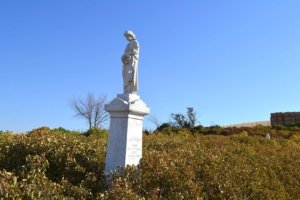The following articles were published in the Walla Walla Union-Bulletin’s series “Walla Walla 2020 and Beyond.” The full series of articles, published monthly, can be found at the UB’s site here.
Bringing Life Back to Historic Cemeteries, Parts I and II
By DANIEL N. CLARK | Walla Walla 2020 and Beyond |
PART I
When Walla Walla 2020 began its Historic Sites and Markers Project in 2012, the first project we took on was the abandoned Poor Farm Cemetery we noticed on old plat maps while looking for properties for our Historic Plaque and Research Service.
After searching for it, we were able to find the unmarked cemetery in a grassy field in the midst of a College Place mobile home park, where all the grave markers had been removed except for several leaning against a tree.
The story of this paupers’ field where 700 burials are still present, and of the recently demolished Poor Farm House and Barn nearby, is a dramatic one that we wanted our community to know.
We have since been glad to tell this story in a number of ways: on signage we’ve installed on site, in a public dedication ceremony, on our Walla Walla 2020 website, as a chapter in our book, “Historic Sites and Markers of Walla Walla County,” and during historic cemetery tours we’ve been asked to lead.
The second abandoned and unmarked graveyard Walla Walla 2020 focused on is the historic McCool Catholic Cemetery on Village Way, which also has a dramatic history that includes the removal of all gravestones, though many burials remain.
After removing the grave markers, the church sold the cemetery land to developers, who were told that all burials had also been removed. Subsequent construction at the site unfortunately resulted in the discovery and disturbance of graves in the street and in some of the new residential lots.
Following our research, Walla Walla 2020 place an interpretive sign on Village Way listing the names of 159 known burials remaining at McCool, though there are undoubtedly others, as we have no records for the period from 1872-1884.
As with the Poor Farm, we also held a public sign dedication ceremony, created a webpage with detailed information on the cemetery’s history, discussed the cemetery and listed those still buried there in our book, and have included the site in cemetery tours.
Several other abandoned cemeteries that have been unmarked and uncared for are included in our book, and in an accompanying historic sites map we’ve published.
Because most of these are important cultural and historic sites, members of the Walla Walla 2020 history committee have researched their history and their legal title, as well as relevant provisions of Washington state law providing for the issuance of certificates of authority for the care and maintenance of historic cemeteries to organizations formed for that purpose.
As a result, our committee members recently formed a new nonprofit, Walla Walla Historic Cemeteries, which currently holds a certificate of authority for the care and maintenance of the Stubblefield (Saling) Cemetery near the corner of Foster and Reser roads, and also for the Lyons Creek (Hendrix) Cemetery near the intersection of Mill Creek and Meiners roads.
This new group has a website which lists those buried in nine historic cemeteries in our area, as well as information about the history of each cemetery and about some of the people buried there.
Walla Walla 2020 has supported this effort by funding the placement of interpretive signs at the Stubblefield and Lyons Creek cemeteries, and by adopting the new group’s work as part of our own program for funding and other purposes.
One of the findings of our research is that the lands on which these two cemeteries were established, as with several other abandoned cemeteries, were legally conveyed by the original homesteaders to cemetery associations which have long been disbanded.
This means such cemeteries are publicly owned, rather than being owned by the adjoining landowners as was often previously assumed.
The rights and interest of the public in learning about, visiting and maintaining these public places has met with resistance by some neighbors, described in a new book soon to be published titled, “Public Places & Private Interests: Protecting Historic Cemeteries, and other Projects.

Restoration of a crumbling stone wall around the Stubblefield family plot, for which an Eagle Scout project cleared encroaching vegetation, is in Stubblefield Cemetery.
PART II
Volunteers with Walla Walla 2020 and its sister organization Walla Walla Historic Cemeteries have encountered considerable vandalism at some abandoned cemeteries, including damage to and theft of gravestones, and in a few cases actual disturbance of the graves.
This has certainly been the case at the Stubblefield Cemetery, where several graves have been opened and a number of gravestones removed. We recovered two of the stolen markers and returned them to the cemetery, where they await reinstallation in an appropriate place.
Since many of the original markers at these cemeteries were made of wood and many of the stone markers have been removed from their original sites, one of our goals at these cemeteries is to apply some remote sensing technologies to the ground to help determine where graves are present.
To do this, we first have to remove downed wood and enough of the ground cover to be able to see the surface when searching for any gravestone bases still present and to use the ground sensing technologies.
This has been particularly demanding at Stubblefield Cemetery, which is in a locust grove and also has major groves of lilacs, as does Lyons Creek. Stubblefield also has a major growth of vinca, or myrtle, over the gravesites, which needs to be removed.
Our ultimate goal there is to map all gravesites, although the absence of burial records for the cemetery makes identification of unmarked burials very difficult.
As each of these cemeteries once had well-laid out rows and individual gravesites, with records of each burial, it may well be that some of these records still exist, though none have been deposited at any community sites.
One purpose of this article is to alert the public to the need for any information residents might have regarding burials at these cemeteries. Names, dates, grave locations, photos, location of stolen markers, biographical information and any other details can be useful in restoring and maintaining the graveyard, as well as educating people of its significance.
The cemetery tours sponsored by the Blue Mountain Land Trust and the Walla Walla chapter of the Archaeological Institute of America have generated considerable interest in the protection and restoration of these cemeteries. We invite interested community members to volunteer to help with mapping tasks, grave marker repair, maintenance, and other work at these important sites.
Our volunteers have been very active at the Stubblefield Cemetery recently, which sits on a dramatic wooded hill looking east toward the Blue Mountains. Their work includes restoration of the cemetery gates with the help of Larry Mallott, and the clearing of downed wood and moving it to natural berms along the cemetery perimeter led by Chris Lueck and Mark Sloan with the assistance of others.
In addition to more clearing, along with grave identification and gravestone repair, another needed task is the restoration of a crumbling stone wall around the Stubblefield family plot, for which an Eagle Scout project cleared encroaching vegetation.
The Washington Trust for Historic Preservation makes the following points about the benefits to be gained by historical preservation and education, with which Walla Walla 2020 and Walla Walla Historic Cemeteries agree:
Preservation represents commitment to remembering the past and preparing for a sustainable future. The benefits of historic preservation are often overlooked because they come to societies as a whole rather than directly and immediately benefiting a developer or property owner.
Preservation of historic properties demonstrates long-term vision by preserving irreplaceable cultural resources and promoting sustainability practices. Historic preservation is the visual and tangible conservation of cultural identity.
Daniel N. Clark is a retired attorney who coordinates Walla Walla 2020 and Walla Walla Historic Cemeteries. He is the author of “Historic Sites & Markers of Walla Walla County.” His new book, “Public Places & Private Interests: Protecting Historic Cemeteries & Other Projects” will soon be released.
Get Involved
Volunteers with Walla Walla 2020 and its sister organization Walla Walla Historic Cemeteries are looking forward to another productive year working to protect and enhance Walla Walla’s historic sites and public places, including its historic cemeteries.
To join the groups and help as part of their new Walla Walla History Corps, go to wwhistoriccemeteries.org or contact them at wwhistoriccemeteries@gmail.com, or ww2020@charter.net, or 509-629-2791.
Contact the groups also with burial information such as names, dates, grave locations, photos, location of stolen markers, biographical information or any other details that may be useful in restoring and maintaining local graveyards and educating the public as to their significance.



